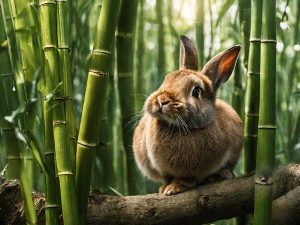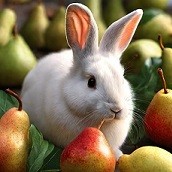Safe Diet Guide: Fresh Bamboo Stalks & Leaves – Are They Nutritious for Pet Rabbits?

Getting to the Root of the Matter
It’s a sight that makes any rabbit owner’s heart melt: those twitchy little noses sniffing around, always curious, always searching for something new to nibble on. But as we all know, not everything that gets a rabbit’s attention should end up in their stomach. So, let’s get right to it – what about bamboo? Is it safe, and is it nutritious?
Bamboo: More Than Just Panda Food
When you think of bamboo, your first thought might be of pandas munching away in a serene Chinese forest. However, bamboo is a versatile plant that’s been used by humans for centuries in crafts, construction, and even
The Nutritional Breakdown
First, let’s dive deep into what bamboo stalks and leaves contain:
- Vitamins: A good source of vitamins, particularly Vitamin C.
- Minerals: Contains potassium, calcium, and magnesium, vital for a rabbit’s wellbeing.
- Fiber: Essential for any rabbit’s diet and digestive health.
On paper, it sounds like a winner, right? However, it’s never that simple.
What Does Science Say?
Research into the dietary habits of rabbits has shown that while they can eat bamboo, it shouldn’t make up a significant portion of their diet. Why? Because bamboo, especially fresh bamboo, contains certain compounds called cyanogenic glycosides. When consumed in large amounts, these can release a small quantity of cyanide, which is harmful.
However, before you panic, remember that many foods contain these compounds, and the occasional bamboo treat is unlikely to cause any harm. Just don’t make it a daily staple.
Consider the Age and Health of Your Rabbit
Young, growing rabbits, and those with health issues, may have different nutritional needs. If bamboo is introduced to their diet, it should be in moderation and always under the close watch of a vet or rabbit nutrition expert.
Variety is the Spice of Life
We all know the saying, and it’s particularly true for our pet rabbits. A varied diet consisting of
So, while bamboo can be part of this variety, remember it’s only one of many foods they can and should eat.
How to Safely Introduce Bamboo to Your Rabbit’s Diet
- Start Small: Like with any new food, begin by offering your rabbit a small piece of bamboo.
- Observe: Watch for any adverse reactions. If there’s diarrhea, refusal to eat, or any other signs of distress, remove the bamboo and consult a vet.
- Frequency: Even if your rabbit loves it, offer bamboo only occasionally.
- Cleanliness: Ensure the bamboo is fresh and free from pesticides or chemicals.
The Verdict: To Feed or Not to Feed?
Here’s my take, and yes, it comes with a bit of controversy. Bamboo can be a great treat for rabbits, but like with all treats, moderation is key. The nutritional benefits are there, but so are potential risks if overfed.
Your rabbit’s health and happiness are paramount. If you choose to feed bamboo, do so responsibly, always putting their well-being first. If ever in doubt, consult your vet or a rabbit nutrition specialist.
Remember, as rabbit owners, we’re their first line of defense. We decide what goes into their diet. So, let’s make those choices count. Every. Single. Time.
Quick Tips for Bunny Bliss
- Diversify: As emphasized, don’t stick to just one type of food. Introduce variety.
- Hydration: Fresh
should always be available. - Playtime: Diet is just one part of a rabbit’s well-being. Ensure they have time to play, hop, and explore.
Final Thought
By following this guide, you’re not just feeding your rabbit; you’re nourishing them. And in return? You’ll get endless bunny binkies, nose boops, and the joy of knowing you’re providing the best care for your furry friend. Here’s to many happy, healthy years with your rabbit companion!
| Feature | Description | References |
|---|---|---|
| Nutritional value | Bamboo stalks and leaves are a good source of fiber, vitamins, and minerals that are beneficial for pet rabbits. | [1][4][5] |
| Feeding guidelines | Bamboo stalks and leaves should be introduced gradually into a rabbit’s diet to avoid digestive problems. They should be given in moderation and should not replace hay and fresh greens. |
[1][4][5] |
| Variety | Rabbits require a variety of feed to obtain necessary nutrients. It is best to mix bamboo stalks and leaves with other forages such as weeds, cultivated plant leaves, and kitchen scraps. |
[3][4][5] |
| Quantity | Bamboo stalks and leaves should be given in small amounts as part of a balanced diet. The main part of a rabbit’s diet should be hay, followed by fresh greens and a small amount of pellets. |
[2][4][5] |
| Risks | Bamboo stalks and leaves should be free from pesticides and other harmful chemicals. | [1][4][5] |
References:
- [1] Central Victoria Hay. “Can Rabbits Munch on Bamboo Shoots? Unveiling a Crunchy Delight for Your Bunny.”
- [2] House Rabbit Society. “Food & Diet.”
- [3] ECHOcommunity. “TN 58 Tropical Rabbit Production: A Guide to Raising Rabbits with Few Resources.”
- [4] Best Friends Animal Society. “Rabbit Diet: What to Feed a Pet Bunny.”
- [5] The Bunny Lady. “Rabbit Diet 101: What To Feed Your Rabbit.”







Leave a Reply